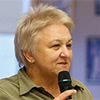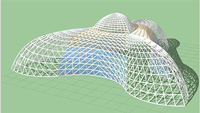Science Digest
Ekaterina Ponomareva, senior lecturer, School of Philology and Language Communication SibFU
Luminous bacteria can help measure radioactivity
Siberian biophysicists have studied the biological effect of low-dose gamma radiation on living organisms. The results of the study are presented in Journal of Environmental Radioactivity which is one of the world's leading scientific journals on the radioactivity of the environment. The luminous bacteria Photobacterium phosphoreum was chosen as a test organism. Their luminescence is suppressed under the influence of a harmful toxic effect. During the test, the bacteria were placed in an experimental capsule, where they were affected by the radiation of different power and duration at three temperatures (+5° C, +10° C, +20° C). Studying the effects of gamma radiation is of current importance because it is more dangerous in comparison to alpha and beta radiation.

Nadezhda Kudryasheva, professor of Siberian Federal University, Institute of Biophysics, Siberian Branch of the Russian Academy of Sciences and a co-author of the publication, says that the results of the study have both fundamental and applied significance: "The results help to understand the nature of the biological effect of low-level radiation at the cellular level. Cells of luminous bacteria are an extremely useful object for such studies. The applied aspect of the work is related to the possibility of using luminous bacteria to determine and monitor the toxicity of the environment. It is known that these bacteria have been widely used for about 50 years to monitor environmental toxicity in case of chemical pollution. Our researches show the prospect of using these bacteria to determine and monitor the toxicity in event of radioactive pollutions".
SibFU press service, March 2017news.sfu-kras.ru/18489
Virtual Archeology of SibFU project unveiled at USA conference

SibFU teachers Nikita Pikov and Ivan Rudov submitted their project Virtual Archeology for the conference Computer Applications & Quantitative Methods in Archeology held in Atlanta, USA, on 14–16 March.
The project features application Virtual Archeology for IOS and Android mobiles and a booklet Samples of Early Cultures of Siberian Taiga with an illustrated dictionary of archeological terms.
The mobile augmented reality application provides access to digital copies of archeological artefacts collected during field works at Shivera Prospikhino Ensemble in 2009–2011. Virtual Archeology is developed on the basis of three-dimensional cross-platform engine Unity. Visual simulation content is based on objects of archeological collection digitized by means of photogrammetry.
To run this application, the user points the camera at the picture in the booklet and up pops an interactive three-dimensional object which is able to revolve, be enlarged and with changeable lighting position. Product developers are planning to supplement the app with graphic and text materials.
SibFU press service, March 2017news.sfu-kras.ru/18528
SibFU scientists offer comfortable Arctic houses
Professors of School of Engineering and Construction N. Abovskiy, L. Endzhievskiy, I. Inzhutov and S. Amelchugov have developed more than fifty innovative technologies to build wooden houses for the Arctic and the Subarctic in the last twenty years to create comfortable living conditions in harsh climate.

These construction technologies are their know-how in more than one way. Wooden pre-assembled units are more mobile than houses made of beams, which simplifies their logistics and assembly. Their manufacturing is also more cost effective and if commercialized, the cost of a house will be two to four times lower than currently. These houses are green and made with the thought of the future, that is they are easy to utilize unlike the metal and reinforced concrete constructions dotted throughout our northern territories after their intensive development in the Soviet period. Moreover, arctic houses are proposed to be equipped with smart systems (as in a smart home), refuse incinerators, mini greenhouses, and multi-stage use of energy is suggested.
At this date construction technologies for the Arctic are at the stage of intellectual property right registration and are awaiting further real life trial, which demands system production. SibFU construction innovations can substantially upgrade housing in the North and substitute imported technologies with their domestic equivalents.
SibFU press service, February 2017news.sfu-kras.ru/18372